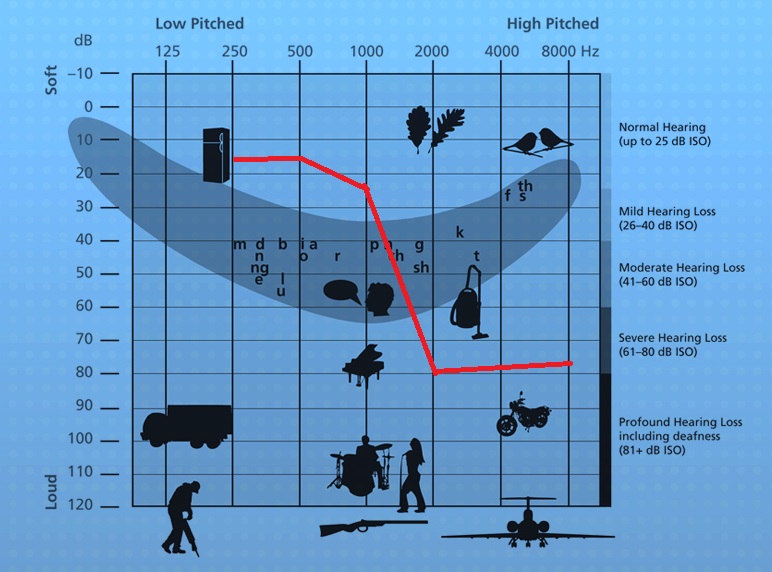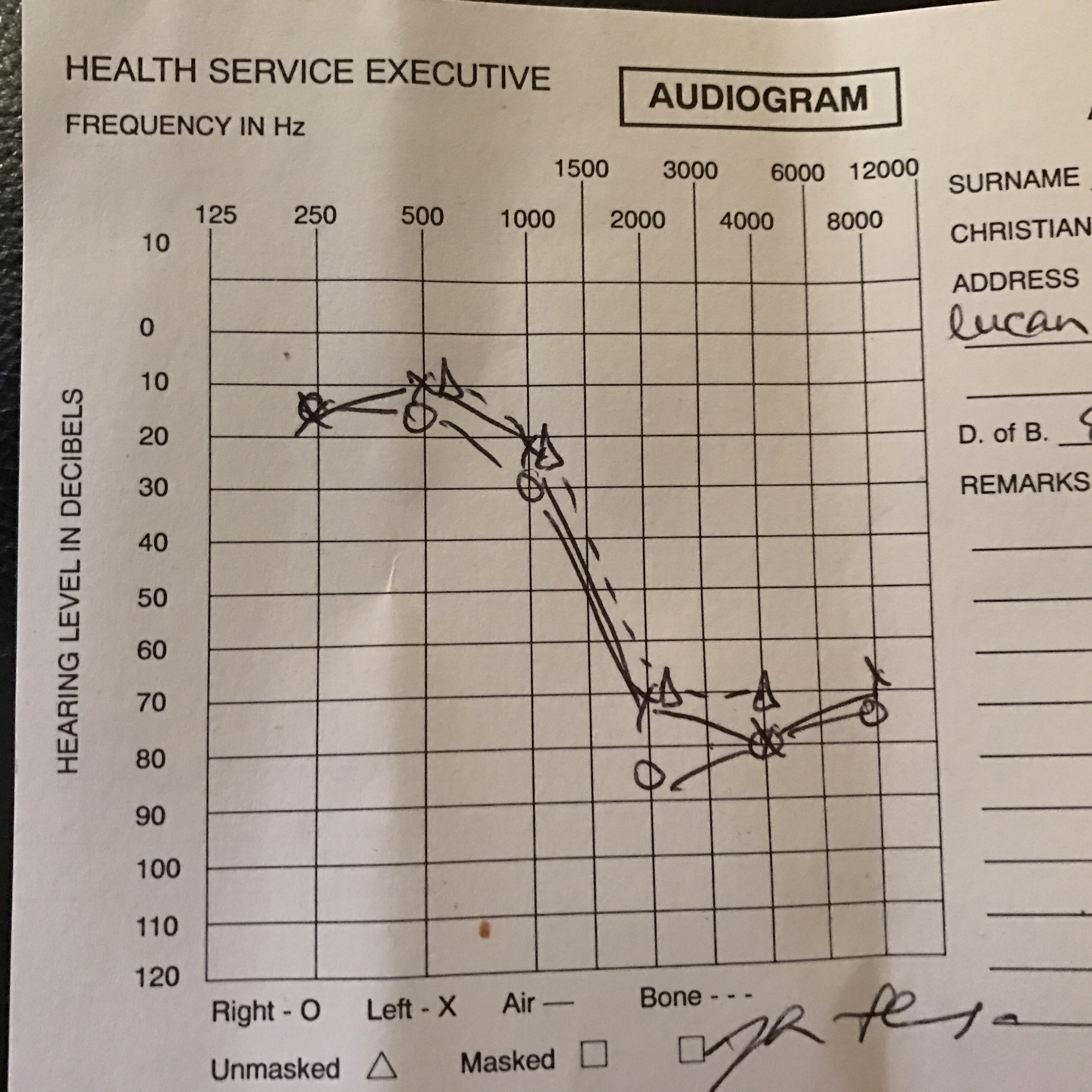This is part of a self-indulgent background series into who I am and what shaped me. I don’t think I can fully discuss preparations for expat life without dealing with these topics!
One of the biggest revelations of my 20s was my own personal discovery of the extent of my hearing loss. I’ve spent well over a decade since trying to figure out what it means for me, my career and my personal life. My question: does my hearing loss define me, and if it does, is this a bad thing?
“A little hard of hearing on one side”
Before I went to an audiologist to get a new hearing aid for my round the world adventures, I would have described myself with 8 simple words: A little hard of hearing on one side.
This was easily understood by people (including me). It meant shout a little louder, like we all did with my beloved granny, and make sure you walk on my right hand side since that was my good ear. It also meant I was a little louder myself – “Decibels, Sinéad,” as my English grandmother used to caution when it got slightly too much for her!
People, especially taxi drivers, would query my accent: “Where are you from?” or, more rudely, “Why do you talk like that?”. And I would explain, rather than go into long winded stories about speech therapy and hearing loss, that my father was English and so I had a mixed accent. In fact, like all alternative facts, I happily believed this. He has a loud voice, so I must have picked up more of his sounds.
So, where had this story come from?
My diagnosis with a hearing loss happened relatively late. I was just about to start school and my speech was slower to start, so I was assessed and fitted with a single hearing aid and attended speech therapy. At no stage do I remember receiving any advice re communicating in school, or living with hearing loss, but I know there was an excellent occupational health specialist who visited my Mum so I suppose it must have been offered at some stage. I attended a mainstream school, was sufficiently nerdy and bright to do well, did OK in speech therapy, socialised relatively well and so life just went on.
I was a book worm and so learned a lot of words from reading versus hearing, which is why you’ll still catch me struggling to pronounce some words. I can see them and know them, but haven’t heard them properly in conversation!
Knowing my limits
I got through my primary schools relatively unscathed, but know that secondary school challenged me. I struggled to fit in with the cliques in an all-girls school, and know now that it was largely because group conversation flew straight over my head. I buried myself in books at lunchtime and it took the pressure off socialising. Equally, activities like Scouts were a roaring disaster – more group work and high volume. I never thought to associate this with hearing, just felt different and it fit the teenage stereotype we all cling to during those years.
I also jettisoned my little hearing aid friend around this time. Sure I had a good side; just needed people to talk to me from it!
However, my awareness took enough shape that I realised just before my Leaving Cert mocks that it was time to raise my hand and ask for help with the aural exams in my Honours Irish and French exams. (For those who don’t know what these are, these are the tapes that were played of conversations and train station announcements, with accompanying comprehension questions.) These tapes never sounded anything less than gobbledygook for me, and the fact that I finally got the cop-on to flag this 4.5 years into second level school was a moment of relative maturity!
Aside: This led to a special combination of oral/aural exams with a Michael D Higgins impersonator of an examiner, who accompanied a conversation about “an eitleán“with arm motions that would leave even a primate in no doubt as to the answer to “what mode of transport is being discussed?”
One of 200 in a lecture theatre
Some of you may have heard about University College Dublin (UCD) 1st year Science lectures, where seats were at such a premium (at least in the first weeks of bouncy enthusiasm) that people were crammed in at every possible seating surface. This was the environment I floundered in for my college education. Foolishly sitting at the back, sans hearing aid, scribbling notes from acetates on a faraway screen and not the foggiest notion of actually trying to follow what the lecturers were saying.
I didn’t engage with disability services. Sure why would I? I was just a little hard of hearing. It wasn’t a real problem.
Socialising was also difficult. Pubs are not a great place when you can’t hear, and add drink to that mix and your ability to concentrate just gets worse, not better. So you either dance (on a good night) or drink (on a messy night) and there are few nights in between.
From a barely passed degree to mature office jobs and relationships. All continuing as normal as can be. Roll on travel plans and a growing sense of trepidation of wading into a world that was going to be real life encounters of those aural tapes from school. How would I manage bus stations? Ordering food? (And to be clear, my now beloved husband and then it’ll-make-or-break-us travel partner, had the linguistic capacity of a rock.)
So I figured, maybe it’s time to get a new hearing aid. You know, it might just help.
Incredulity
This was the print out.
So I get what you’re thinking. What the blazes does this all mean? I felt that too the evening I saw this chart for the first time.
It meant, however, a lot to the audiologist standing across from me. His exact words stick with me to this day: “You’re seriously telling me you got through school and college without wearing your hearing aid? And you definitely only ever had one hearing aid?”
His incredulity gave me a little indication that “a little hard of hearing” might just have been wide of the mark.
The first thing you need to understand about that small chart is that it contains a lot of information. During the test they play sounds to each ear at different frequencies and record your reaction to this. The numbers across the top are the frequency of sounds. Frequency is best understood as ranging from low frequency (noises like the bass notes on a piano) to high frequency (like a bird cheeping). Across the left it shows the decibels required to hear that sound during the test. That record then is mapped like above in a chart called an audiogram. Hearing Link explain this better than I can!
Let’s interpret this from my perspective:
- Those little Os and Xs on that chart indicate the right ear and left ear. Yup, both ears are exactly the same, equally poor at doing basic ear-functions like hearing. I had no “good side”. Simon, to this day, still walks on my right!
- A person with “normal” hearing will hear their softest sounds between -10 and 20 Db. Mine is therefore normal up to 500 Hz frequency, but then you’ll see it starts to drop, fast.
- I had severe high frequency hearing loss, not a “slightly hard of hearing, sure-shout-a-little type hearing loss”. This is better known as ski slope hearing loss, given that it’s basically an uncontrolled downhill slide from which there’s no recovery. Unfortunately, it doesn’t come with après-ski!
My speech banana
All of the above is theoretical, but it can be hard to see how this relates to “real” hearing. This is where a speech banana comes in. Now, don’t laugh at the name, but look at this graph and you’ll see how it relates to the audiogram above. It basically shows where common sounds would fall on the audiogram.

For me, this speech banana helps to explain my everyday struggles. It becomes easier to see when I map my results on it.
This is my speech banana:

I can’t hear high frequency sounds, like the consonant sounds “t, c, s, p”. It’s which I can never distinguish between f and s when people spell their names. It’s why birds singing are silent to me. It explains why I sometimes speak strangely. It also explains why I was (excuse my french!) buggered when I did reception cover in a busy Chicago bank during my J1 summer. Names I’d never heard of being spelled out over the phone! Quite a few people got “cut off” that summer or their messages never passed on!
So what?
So, I didn’t quite get all of the information above in the first visit to the audiologist but I did hear something that would become a mantra for my life. Basically, my hearing loss is hard to treat with hearing aids. Think about how a hearing aid works: it amplifies volume. Old aids, such as the helpful single 1980s aid I had during my youth, would simply make everything louder. Great in theory, but when the challenge is distinguishing high frequency sounds, having louder background noise doesn’t help.
Modern technology has improved, but it’s still a challenge. It’s also why I largely get away without wearing my hearing aids. I find them hard in a busy office environment, as even with the latest technology embedded in them, I still can’t handle the extra amplification of background noise. I end up shutting it all out, leading me to embarrassing moments where colleagues are practically jumping up and down beside me to get my attention!
Hear like I hear
This handy video from Phonak might help you hear as I hear:
So what?
I guess I’m self-consciously sharing this story and my experience in the hope that people might understand my hearing loss a little better.
I asked earlier whether it defines me, and I suspect there’s another blog post (or several) needed to answer that.
However, I definitely learned plenty about myself after my initial anger at being misinformed about the extent of my hearing loss for so many years. Knowing the extent of my hearing loss allowed me to discover, and embrace, subtitles on page 888 on Teletext and fueled an interest in accessibility and the need to ensure subtitling of video/TV content. It allowed me to accept my lack of ability in noisy group settings and to forgive myself for being the person engaging in 1:1 chat at parties versus the centre of group talk.
There is much more to say, especially regarding my fears regarding living in a country with a multitude of accents and strange names, but that’s best saved for another day in which I can share my love of Amy Cuddy and faking it until you make it!
Image source: Ear, by Hana Tichá




